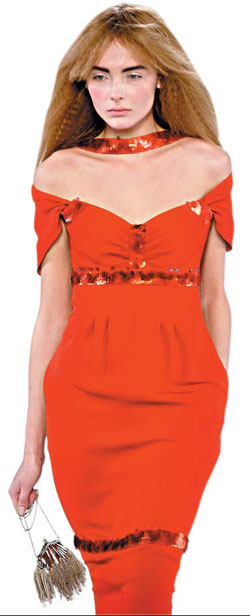The year designers grew up
Grown-up clothes become the highlights on Paris catwalks, such as the creation by Chanel. Reuters |
As soon as the curtain went up on the Marc Jacobs show in New York four weeks ago it became clear that designers were moving on at last from their blinkered obsession with youth.
In his show Jacobs moved away from the grunge influences and teenage styles that he usually uses and instead presented full-length narrow skirts and blouses so ladylike they seemed to have come straight out of Jackie Onassis's closet.
It has been a similar story throughout the month: hemlines now actually make it past the upper thighs to hit the knees, and dresses, particularly in the Chanel and Marni shows, were made for a woman's shape as opposed to that of a flat-chested teenager, even if that is who designers still insist on getting to model the clothes.
"The shows have been much more grown up and polished this time," said Anna Wintour, editor of US Vogue. She cited Marc Jacobs, Marni and Prada as particularly strong. Retailers were equally pleased. "Grown-up clothes are more appealing because customers need to be able to project themselves into them," said Natalie Massenet of luxury fashion website net-a-porter.com.
Aside from the maturity of the clothes, the other big surprise was the almost total lack of accessories. For the past decade, and increasingly so in the past five years, catwalks have strained under the weight of television set-sized handbags and boat-like wedge shoes, with the clothes often looking of secondary importance.
And with good reason: according to Mintel, the consumer market research firm, the accessories business, particularly handbags, is the fastest growing sector of the luxury fashion market. The leather goods market alone grew to $20.3 billion in 2005, up from $15.59 billion in 2001 and far exceeding growth in the overall luxury market.
Yet judging from the catwalks for the next season, this obsession with the latest it bags has reached saturation point. Even brands known for their handbags kept them to a discreet minimum and few were bigger than reasonable.
Prada featured hardly any, whereas just last year the models were made to walk up and down the catwalk dragging heavy wheelie luggage behind them.
Only the very disappointing Chloe show, in which new designer Paolo Melim Andersson presented his first collection for the label, featured oversized bags and oversized shoes. But these were most likely filling the function of how accessories once worked on the catwalks: as a desperate means of distracting the audience from looking at the clothes too carefully.
Considering the general dreariness of the show, with sloppy tunic dresses, strange squiggle patterns and cheap looking embellishment, this tactic was probably wise.
For consumers, this rejection of handbags weighed down by giant gold chains and padlocks can only be good news. It means that no longer will one be expected to pay $1,733 for a decent handbag that is so heavy you will probably develop curvature of the spine for the privilege of carrying it.
One might have thought that retailers would be less happy. For them the accessories explosion has been of enormous financial benefit because bags and shoes are much easier to sell than long gowns and are cheaper to stock because they don't require space for changing rooms.
Yet in Paris buyers unanimously expressed relief at this change, not least because of a sense of growing customer fatigue with it bags.
"Accessories are a very important market for us but a woman only needs a couple of great bags and shoes," said Natalie Massenet.
"We're not worried about the fewer handbags because now we're seeing things like hats and gloves on the catwalks, so it's no longer just about bags," agreed Anne Pitcher, buying and merchandizing director for Selfridges, the British department store.
As the emphasis is back on the clothes, many of the collections featured clothes so complex they could almost be couture, particularly in the beautiful Balenciaga, Yves Saint Laurent and Christian Dior collections.
This, too, pleased luxury retailers because they see it as a way to gazump the all-powerful high street.
"You can get a slouchy woman's tunic at different price points. But if you want a great pair of trousers or a dress with delicate pleating you're going to have to spend a little more," said Massenet. Well, the customer can't always win.
The Guardian
(China Daily 03/08/2007 page19)















